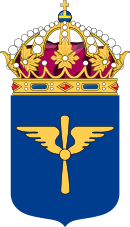Royal Swedish Air Force
| Swedish Air Force | |
|---|---|

Swedish Air Force Coat of arms
|
|
| Founded | July 1, 1926 |
| Country |
|
| Allegiance | HM King Carl XVI Gustaf |
| Part of | Swedish Armed Forces |
| March |
Flygvapnets Defileringsmarsch (March of the Swedish Air Force), by Helge Damberg |
| Engagements |
Winter War Congo Crisis Afghanistan War 2011 military intervention in Libya |
| Commanders | |
| Chief of Air Force | Major General Mats Helgesson |
| Insignia | |
| Roundels |
 
|
| Aircraft flown | |
| Electronic warfare |
S 102B Korpen, S 100 Argus |
| Fighter | Saab JAS 39 Gripen |
| Helicopter | A109, NH90, UH-60M |
| Trainer | Saab 105 |
| Transport | Lockheed C-130H, Saab 340, Gulfstream IV, Gulfstream 550 |
The Swedish Air Force (Swedish: Flygvapnet) is the air force branch of the Swedish Armed Forces.
The Swedish Air Force was created on July 1, 1926 when the aircraft units of the Army and Navy were merged. Because of the escalating international tension during the 1930s the Air Force was reorganized and expanded from four to seven squadrons. When World War II broke out in 1939 further expansion was initiated and this substantial expansion was not finished until the end of the war. Although Sweden never entered the war, a large air force was considered necessary to ward off the threat of invasion and to resist pressure through military threats from the great powers. By 1945 the Swedish Air Force had over 800 combat-ready aircraft, including 15 fighter divisions.
A major problem for the Swedish Air Force during World War II was the lack of fuel. Sweden was surrounded by countries at war and could not rely on imported oil. Instead domestic oil shales were heated to produce the needed petrol.
The Swedish Air Force underwent a rapid modernization from 1945. It was no longer politically acceptable to equip it with second-rate models. Instead, the Air Staff purchased the best it could find from abroad, e.g. P-51D Mustangs, De Havilland Mosquito NF.19 night fighters and de Havilland Vampires, and supported the development of top performance domestic models. When the Saab 29 Tunnan fighter was introduced around 1950, Sweden suddenly had planes that were equal to the best of the Royal Air Force, the Soviet Union's VVS, and the U.S. Air Force.
During the 1950s the air force started to build road bases after an idea taken from Germany. Built under the BASE 60 distributed airfield scheme, the bases were ordinary highways constructed in such a way that they could also serve as landing strips. In the early eighties road number 44 was rebuilt to contain four short runways (17 x 800 metres). Along the road a large number of turn-around-sites for rearming and refueling were built. These short runways are still used today for training, landing and taking off with Gripen and Hercules as preparation for international operations under adverse conditions.
...
Wikipedia
